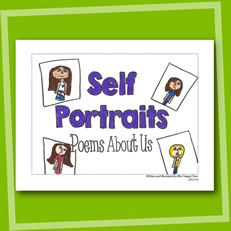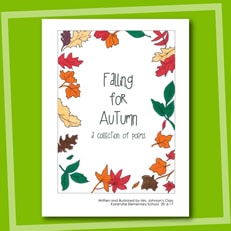 Although teaching poetry to elementary students may be challenging at first, poetry is a lot of fun once they get the hang of it. It’s like dancing with words instead of feet. It can be lyrical or loose and free, a joyous foxtrot or a melancholy minuet. And, like dance, poetry can be personal, but is so much more powerful when it’s shared with others.
Although teaching poetry to elementary students may be challenging at first, poetry is a lot of fun once they get the hang of it. It’s like dancing with words instead of feet. It can be lyrical or loose and free, a joyous foxtrot or a melancholy minuet. And, like dance, poetry can be personal, but is so much more powerful when it’s shared with others.
These fun ideas for publishing student poetry books give your students the opportunity to share their own poems with the world and shine a spotlight on their unique creative talents and potential.
 Poetry Book Idea #1: Framed Poems
Poetry Book Idea #1: Framed Poems
 Just like framed sentences and paragraph are a great writing strategy for introducing very young students to the basics of writing prose, framed poems are a perfect first introduction to writing poetry. Start with short poems—four to six lines at most—and use the blanks to help your students practice everything from using descriptive language to learning how to rhyme. For early practice, you might even use an existing poem as an example and have your students write their own versions using the same structure before moving on to creating and publishing their own original poems.
Just like framed sentences and paragraph are a great writing strategy for introducing very young students to the basics of writing prose, framed poems are a perfect first introduction to writing poetry. Start with short poems—four to six lines at most—and use the blanks to help your students practice everything from using descriptive language to learning how to rhyme. For early practice, you might even use an existing poem as an example and have your students write their own versions using the same structure before moving on to creating and publishing their own original poems.
PROJECT IDEA
In their poetry classbook Self Portraits: Poems About Us, Mrs. Staggs’s 1st graders used a simple four-line structure to write their very own self-portrait poems. Despite all using the same frame, each poem is as unique and lovely as the poet who wrote it thanks to the wealth of imaginative figurative language used to describe each student. Even Mrs. Staggs joined in on the fun by including her own poem and portrait at the end of the published book!
 Poetry Book Idea #2: Reviewing in Rhyme
Poetry Book Idea #2: Reviewing in Rhyme
 The purpose of this idea for publishing a student poetry book is twofold. Not only is it great writing practice for your poets-in-training, it’s also a wonderfully unusual way to review all the other interesting things they’ve learned so far in your class. Simply choose a theme you’ve covered in class, such as historical events or fairy tales, and ask each student to write their own poem about a specific subject that falls under that theme. For instance, if you chose historical events, one student might write a poem about the first moon landing, while another might write about the French Revolution. (For younger students, a simpler theme—such as “colors” or “planets”—might work best.)
The purpose of this idea for publishing a student poetry book is twofold. Not only is it great writing practice for your poets-in-training, it’s also a wonderfully unusual way to review all the other interesting things they’ve learned so far in your class. Simply choose a theme you’ve covered in class, such as historical events or fairy tales, and ask each student to write their own poem about a specific subject that falls under that theme. For instance, if you chose historical events, one student might write a poem about the first moon landing, while another might write about the French Revolution. (For younger students, a simpler theme—such as “colors” or “planets”—might work best.)
PROJECT IDEA
When writing and publishing their book of Kansas Animal Poetry, Mrs. Marker’s class chose to use everything they’d learned about local animal life in class as inspiration for their poems. Weaving facts in with creative descriptions and opinions, each student wrote four full rhyming stanzas about specific animals that are found in Kansas, such as red foxes and woodchucks. The result? A beautiful and informative book of student poetry that both delights and educates!
Are you Enjoying this Content?
 Poetry Book Idea #3: Exploring Different Rhyme Schemes
Poetry Book Idea #3: Exploring Different Rhyme Schemes
 Just like prose, poetry comes in all sorts of intriguing shapes and sizes. Consider structuring your next poem-writing project in a way that allows your students to explore and discover more about all the different forms a poem can take. Brainstorm an overall theme to write about, such as growing up or the meaning of friendship. Choose several different forms, such as limericks, couplets or blank verse, and ask each student to choose (or randomly assign each student) one form to use for their poem. When publishing your students’ book of poetry, be sure to organize poems by type so that they can more clearly see the differences between the various forms once your published book arrives.
Just like prose, poetry comes in all sorts of intriguing shapes and sizes. Consider structuring your next poem-writing project in a way that allows your students to explore and discover more about all the different forms a poem can take. Brainstorm an overall theme to write about, such as growing up or the meaning of friendship. Choose several different forms, such as limericks, couplets or blank verse, and ask each student to choose (or randomly assign each student) one form to use for their poem. When publishing your students’ book of poetry, be sure to organize poems by type so that they can more clearly see the differences between the various forms once your published book arrives.
PROJECT IDEA
Mrs. Johnson’s class used this idea for their beautifully organized classbook poetry project Falling For Autumn. Two students each tackled a different form or structure, including acrostic, cinquain and diamante poems. Each section is prefaced with a definition of the poetry type it includes as well as brief biographies of the two poets whose work it features.
The Perks of Publishing Student Poetry
Whether they’re writing framed poems, rhyming reviews or exploring how the same concept can be expressed differently depending on the type of poem used, your students are sure to surprise themselves—and you—with what they can come up with when they really try. One of the best ways to motivate your students to put their all into their poetry is to use the promise of publication as an extra incentive. Knowing their work will be out there for everyone to see holds them accountable in a way letter grades and peer reviews can’t quite replicate, and imagining how their work will look on the printed page will inspire them to create something they’ll be proud of and eager to share. And when your proud, new authors finally hold their books in their hands for the first time, it’ll be as much of a reward for them as it will be for you.
For more fun poetry prompts and other creative writing resources for your elementary students, check out our online teacher’s lounge, and sign up for your free publishing kit!
Image sources: Lead image via Shutterstock; Images 1, 2, 3 via OpenClipart.org








